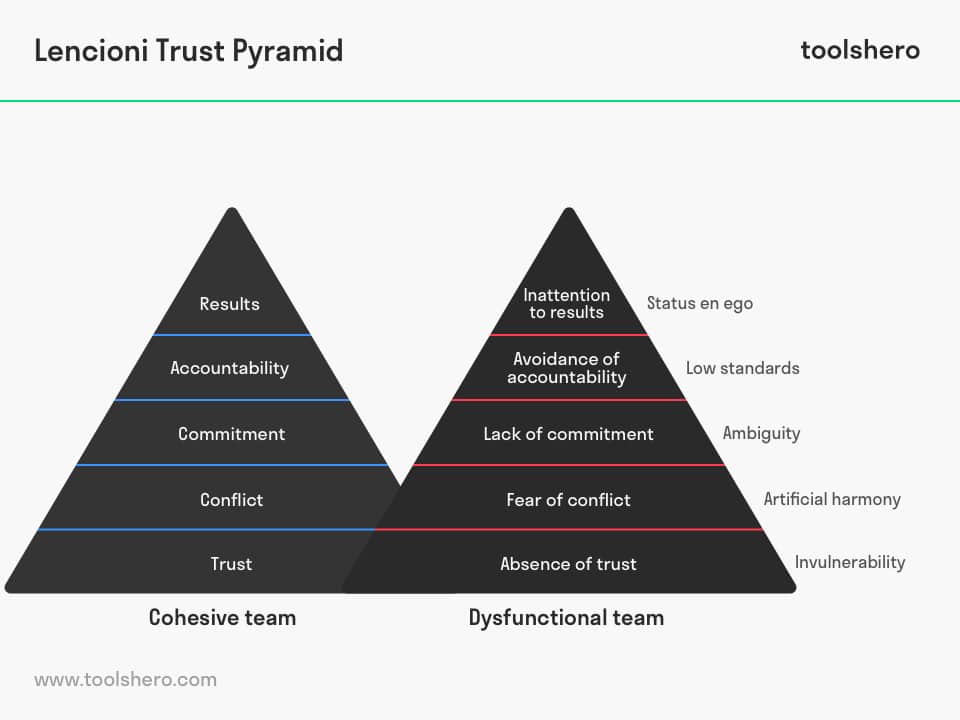Lencioni Trust Pyramid explained

Lencioni Trust Pyramid: this article explains the Lencioni Trust Pyramid in a practical way. After reading this article you will understand the basis of this powerful tool for team development, group dynamics and teambuilding.
What is the pyramid of Lencioni / Lencioni Trust Pyramid?
The Lencioni Trust Pyramid was developed and published by Patrick Lencioni, an American management consultant, in his own book ‘The Five Dysfunctions of a Team’ (2002).
The book is written in a narrative manner, so that figures and situations from the book can easily be recognised in practice. The five most important pitfalls of a team are clearly mapped out in the model, so that they can work towards a successful and effective team.
In order to develop the team with the aid of the Lencioni Trust Pyramid model, it is necessary that all team members are able to and want to work on the team. The realisation that something needs to be changed is important to get more potential from the team.
Lencioni Trust Pyramid: five layers
The Lencioni Trust Pyramid is divided into five layers, starting at the bottom of the model. Characteristic of a pyramid is that all underlying layers must be supported sufficiently before they can be constructed.
The bottom layer of the pyramid is the largest and therefore also the most important. However, in order for a team to function effectively, it is important that all levels and requirements are fulfilled. Lencioni states that his model can be interpreted both negatively and positively.

Figure 1- Lencioni Trust Pyramid
1. Trust versus invulnerability
The foundation of the Lencioni Trust Pyramid, the foundation, consists of trust. If this foundation fails, the team will fall apart. Getting to know team members is a good start.
In this way, colleagues get to know more about each other’s private lives, their standards and values, and pronouncing someone’s strong or weak points becomes easier. Giving and receiving constructive feedback is essential in building trust.
Trust also means that team members must be able to be vulnerable. When mistakes are made, this must be admitted openly. Frustrations must also be expressed to keep the atmosphere in the team healthy.
In practice, however, this is not always done, but instead members complain about the workload or doubt in the performance of an employee in the canteen. According to Lencioni, these matters should be talked about so that no frustrations are suppressed and a solution can be worked towards.
2. Constructive conflicts versus artificial harmony
Since each person is different from the other, conflicts in teams regularly occur. Conflicts also arise in sustainable business relations. These ensure a stronger bond, just like in another relationship, provided they are talked out.
However, serious discussions are too often avoided, while they actually contribute to a well-functioning team. Teams that tackle conflicts have vivid and active meetings, and look for solutions to the real problem.
The trust from the foundation of the pyramid certainly affects this. When a team member continues to speak up, there is no frustration and the conflict does not lead a life of its own.
Yet there is a taboo on conflicts. The fear of confrontations ensures that many aspects that are not discussed, are not on the agenda. The fear of confrontation is unjust, but stems from the misconception that confrontation is synonymous with an argument.
When nobody expresses him / herself in the group, there is only artificial harmony and the problem is never addressed. It is precisely these constructive conflicts that lead to progress.
3. Commitment versus ambiguity
When team members are involved and committed, it creates clarity and support. The degree of involvement of team members can only be high when the first two levels of the Lencioni Trust Pyramid are present in the team.
Although there may be solidarity within a team, this does not mean that everyone agrees on every aspect. A team in which unity prevails takes choices without doubting, as arguments from both sides are already heard.
When group members are not committed to each other and the work, ambiguity prevails. Often it will not be clear which course the team is on and opinions will be shared less frequently.
A common decision that is made is to choose the safe middle way. However, it is much more valuable to find out which aspects have priority and what the right direction is through reasoning or a good discussion.
4. Accountability versus low standards
Accountability is the second to last level of Lencioni Trust Pyramid. Although this is a characteristic that is often assigned to someone individually, the team does have a responsibility as a whole.
In an individual sense it comes down to taking responsibility for behaviour, attitude and results. It is important to take responsibility also in small things. If a colleague often arrives late and this isn’t addressed, chances are that in the future the bar will be even lower.
Ignoring responsibility results in differing views about the required quality of results. It can also lead to worse; missed deadlines or forgetting of important agreements.
At this level of the pyramid the relationship with the second level is also present. As long as not everything is expressed or talked over, frustration remains.
5. Results versus status and ego
The final level of the Lencioni Trust Pyramid consists of results. Lencioni indicates that a major frustration in a team is the tendency of the team members to focus more on other aspects than the objectives.
Focus and determination are necessary to achieve a good result. A focused team enjoys success and minimises individualistic behaviour. The leader of the team has an important role in this. The leader sets the intended results and remains objective at all times.
In a group where results do not come first, it will be difficult to achieve the objectives. Instead, personal interest often takes precedence over the collective. A person can seek credit for performance achieved by the whole group. Frustrations may also arise.
According to Lencioni, the term ‘team’ is used far too often and there are few groups of people who meet the definition of a team.
He draws the comparison with marriage: ‘However much we want to work together, becoming and remaining a team requires dedication and discipline. It is just like a good marriage. A marriage is not just positive by itself. You have to constantly work for it.
Conclusion about the Lencioni Trust Pyramid
Working in a team can bring many benefits. However, there are also challenges that need to be addressed. Lencioni emphasises that a team is built on trust, but that openness, involvement, responsibility and focus on results should never be lacking. Improving the effectiveness of a team is not easy, but yields valuable results in the long term.
It’s Your Turn
What do you think? Do you work in a team and do you recognize the dynamics and the challenges that go with this? Can you turn the tide by applying the Lencioni Trust Pyramid?
Share your experience and knowledge in the comments box below.
More information
- Baldoni, J. (2008). Lead by example: 50 ways great leaders inspire results. AMACOM Div American Mgmt Assn.
- Secretan, L. (2004). Inspire! What great leaders do. John Wiley & Sons.
- Sinek, S. (2009). Start with why: How great leaders inspire everyone to take action. Penguin.
How to cite this article:
Janse, B. (2018). Lencioni Trust Pyramid. Retrieved [insert date] from Toolshero: https://www.toolshero.com/leadership/lencioni-trust-pyramid/
Original publication date: 06/24/2018 | Last update: 09/11/2023
Add a link to this page on your website:
<a href=”https://www.toolshero.com/leadership/lencioni-trust-pyramid/”> Toolshero: Lencioni Trust Pyramid</a>












